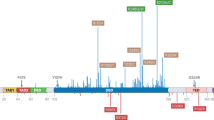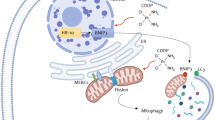Abstract
p53 mutations occur frequently in human tumors. The low-molecular-weight compound PRIMA-1MET reactivates mutant p53, induces apoptosis in human tumor cells and inhibits tumor xenograft growth in vivo. Here, we show that PRIMA-1MET induces mutant p53-dependent mitochondria-mediated apoptosis through activation of caspase-2 with subsequent cytochrome c release and further activation of downstream caspase-9 and caspase-3. Inhibition of caspase-2 by a selective inhibitor and/or siRNA prevents cytochrome c release on PRIMA-1MET treatment and causes a significant reduction in PRIMA-1MET-induced cell death. Our findings highlight a chain of cellular events triggered by PRIMA-1MET that lead to apoptotic cell death. This should facilitate further development and optimization of efficient PRIMA-1MET-based anticancer drugs.
This is a preview of subscription content, access via your institution
Access options
Subscribe to this journal
Receive 50 print issues and online access
$259.00 per year
only $5.18 per issue
Buy this article
- Purchase on Springer Link
- Instant access to full article PDF
Prices may be subject to local taxes which are calculated during checkout








Similar content being viewed by others
Abbreviations
- Δψm:
-
mitochondrial membrane potential
- FACS:
-
fluorescence-activated cell sorting
- G3PDH:
-
glyceraldehyde-3phosphate dehydrogenase
- PI:
-
propidium iodide
- fmk:
-
fluoromethyl ketone
References
al-Shabanah OA, Osman AM, al-Harbi MM, al-Bekairi AM, al-Gharably NM, Aziz SA . (1995). Diltiazem potentiation of doxorubicin cytotoxicity and cellular uptake in Ehrlich ascites carcinoma cells. Chemotherapy 41: 368–377.
Bergeron L, Perez GI, Macdonald G, Shi L, Sun Y, Jurisicova A et al. (1998). Defects in regulation of apoptosis in caspase-2-deficient mice. Genes Dev 12: 1304–1314.
Bergh J, Norberg T, Sjogren S, Lindgren A, Holmberg L . (1995). Complete sequencing of the p53 gene provides prognostic information in breast cancer patients, particularly in relation to adjuvant systemic therapy and radiotherapy. Nat Med 1: 1029–1034.
Bykov VJ, Issaeva N, Shilov A, Hultcrantz M, Pugacheva E, Chumakov P et al. (2002). Restoration of the tumor suppressor function to mutant p53 by a low-molecular-weight compound. Nat Med 8: 282–288.
Bykov VJ, Issaeva N, Zache N, Shilov A, Hultcrantz M, Bergman J et al. (2005a). Reactivation of mutant p53 and induction of apoptosis in human tumor cells by maleimide analogs. J Biol Chem 280: 30384–30391.
Bykov VJ, Selivanova G, Wiman KG . (2003). Small molecules that reactivate mutant p53. Eur J Cancer 39: 1828–1834.
Bykov VJ, Zache N, Stridh H, Westman J, Bergman J, Selivanova G et al. (2005b). PRIMA-1(MET) synergizes with cisplatin to induce tumor cell apoptosis. Oncogene 24: 3484–3491.
Chipuk JE, Bouchier-Hayes L, Kuwana T, Newmeyer DD, Green DR . (2005). PUMA couples the nuclear and cytoplasmic proapoptotic function of p53. Science 309: 1732–1735.
Chipuk JE, Maurer U, Green DR, Schuler M . (2003). Pharmacologic activation of p53 elicits Bax-dependent apoptosis in the absence of transcription. Cancer Cell 4: 371–381.
Ding HF, Lin YL, McGill G, Juo P, Zhu H, Blenis J et al. (2000). Essential role for caspase-8 in transcription-independent apoptosis triggered by p53. J Biol Chem 275: 38905–38911.
Fulda S, Debatin KM . (2006). Extrinsic versus intrinsic apoptosis pathways in anticancer chemotherapy. Oncogene 25: 4798–4811.
Gross A, Yin XM, Wang K, Wei MC, Jockel J, Milliman C et al. (1999). Caspase cleaved BID targets mitochondria and is required for cytochrome c release, while BCL-xL prevents this release but not tumor necrosis factor-R1/Fas death. J Biol Chem 274: 1156–1163.
Guimaraes DP, Hainaut P . (2002). TP53: a key gene in human cancer. Biochimie 84: 83–93.
Guo Y, Srinivasula SM, Druilhe A, Fernandes-Alnemri T, Alnemri ES . (2002). Caspase-2 induces apoptosis by releasing proapoptotic proteins from mitochondria. J Biol Chem 277: 13430–13437.
Lassus P, Opitz-Araya X, Lazebnik Y . (2002). Requirement for caspase-2 in stress-induced apoptosis before mitochondrial permeabilization. Science 297: 1352–1354.
Lin Y, Ma W, Benchimol S . (2000). Pidd, a new death-domain-containing protein, is induced by p53 and promotes apoptosis. Nat Genet 26: 122–127.
Nakano K, Vousden KH . (2001). PUMA, a novel proapoptotic gene, is induced by p53. Mol Cell 7: 683–694.
Olivier M, Langerod A, Carrieri P, Bergh J, Klaar S, Eyfjord J et al. (2006). The clinical value of somatic TP53 gene mutations in 1,794 patients with breast cancer. Clin Cancer Res 12: 1157–1167.
Read SH, Baliga BC, Ekert PG, Vaux DL, Kumar S . (2002). A novel Apaf-1-independent putative caspase-2 activation complex. J Cell Biol 159: 739–745.
Robertson JD, Enoksson M, Suomela M, Zhivotovsky B, Orrenius S . (2002). Caspase-2 acts upstream of mitochondria to promote cytochrome c release during etoposide-induced apoptosis. J Biol Chem 277: 29803–29809.
Schuler M, Bossy-Wetzel E, Goldstein JC, Fitzgerald P, Green DR . (2000). p53 induces apoptosis by caspase activation through mitochondrial cytochrome c release. J Biol Chem 275: 7337–7342.
Tinel A, Tschopp J . (2004). The PIDDosome, a protein complex implicated in activation of caspase-2 in response to genotoxic stress. Science 304: 843–846.
Tyagi A, Singh RP, Agarwal C, Agarwal R . (2006). Silibinin activates p53 caspase-2 pathway and causes caspase-mediated cleavage of Cip1/p21 in apoptosis induction in bladder transitional-cell papilloma RT4 cells: evidence for a regulatory loop between p53 and caspase-2. Carcinogenesis 27: 2269–2280.
Vakifahmetoglu H, Olsson M, Orrenius S, Zhivotovsky B . (2006). Functional connection between p53 and caspase-2 is essential for apoptosis induced by DNA damage. Oncogene 25: 5683–5692.
Ventura A, Kirsch DG, McLaughlin ME, Tuveson DA, Grimm J, Lintault L et al. (2007). Restoration of p53 function leads to tumour regression in vivo. Nature 445: 661–665.
Xue W, Zender L, Miething C, Dickins RA, Hernando E, Krizhanovsky V et al. (2007). Senescence and tumour clearance is triggered by p53 restoration in murine liver carcinomas. Nature 445: 656–660.
Yin XM . (2006). Bid, a BH3-only multi-functional molecule, is at the cross road of life and death. Gene 369: 7–19.
Yu J, Zhang L, Hwang PM, Kinzler KW, Vogelstein B . (2001). PUMA induces the rapid apoptosis of colorectal cancer cells. Mol Cell 7: 673–682.
Acknowledgements
This study was supported by grants from the Swedish and Stockholm Cancer Societies, the Swedish Research Council, the EU 6th and 7th Framework Programs, and Karolinska Institutet. This publication reflects the author's views and not necessarily those of the EC partners. The information in this document is provided as is and no guarantee or warranty is given that the information is fit for any particular purpose. The user thereof uses the information at its sole risk and liability. The Community is not liable for any use that may be made of the information contained herein.
Author information
Authors and Affiliations
Corresponding author
Additional information
Supplementary Information accompanies the paper on the Oncogene website (http://www.nature.com/onc)
Rights and permissions
About this article
Cite this article
Shen, J., Vakifahmetoglu, H., Stridh, H. et al. PRIMA-1MET induces mitochondrial apoptosis through activation of caspase-2. Oncogene 27, 6571–6580 (2008). https://doi.org/10.1038/onc.2008.249
Received:
Revised:
Accepted:
Published:
Issue Date:
DOI: https://doi.org/10.1038/onc.2008.249
Keywords
This article is cited by
-
Traditional Chinese medicine for colorectal cancer treatment: potential targets and mechanisms of action
Chinese Medicine (2023)
-
Repurposing of neprilysin inhibitor ‘sacubitrilat’ as an anti-cancer drug by modulating epigenetic and apoptotic regulators
Scientific Reports (2023)
-
Strong synergy with APR-246 and DNA-damaging drugs in primary cancer cells from patients with TP53 mutant High-Grade Serous ovarian cancer
Journal of Ovarian Research (2016)
-
PRIMA-1MET induces death in soft-tissue sarcomas cell independent of p53
BMC Cancer (2015)
-
APR-246 overcomes resistance to cisplatin and doxorubicin in ovarian cancer cells
Cell Death & Disease (2015)



